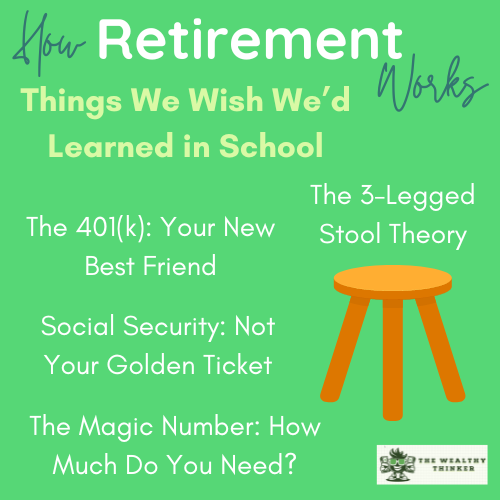Remember those days in high school when we learned about the Pythagorean theorem and the intricacies of photosynthesis?
While that knowledge is great for trivia nights, many of us left school without a clue about something far more crucial to our adult lives: how retirement works.
If you’re sitting there thinking, “Wait, isn’t retirement just stopping work and chilling?” – buckle up because we’re about to dive into the retirement crash course you never got but desperately need.
It’s crucial to think about how you’ll spend your time, not just your money.

The Basics: What Even is Retirement?
At its core, retirement is the phase of life when you stop working full-time and live off the savings and investments you’ve accumulated over your working years.
Sounds simple, right?
Well, not so fast. Retirement isn’t just about quitting your job and lounging on a beach (though that can certainly be part of it).
It’s a financial journey that starts way before you say goodbye to your 9-to-5.
How Retirement Works: The Three-Legged Stool
Financial experts often talk about the “three-legged stool” of retirement. No, it’s not a piece of furniture – it’s a metaphor for the three main sources of retirement income:
- Social Security: The government-provided safety net we all contribute to during our working years.
- Employer-sponsored retirement plans: Think 401(k)s, 403(b)s, or pensions if you’re lucky.
- Personal savings and investments: Your own nest egg that you’ve built up over time.
Ideally, all three legs should be strong enough to support you in retirement. But here’s the kicker – many people find their stool is a bit wobbly when they reach retirement age.
Top 3 Risks, 4 Benefits & When is the Right Time to Use Your 401K
Social Security: Not Your Golden Ticket
Let’s burst a bubble right away: Social Security alone probably won’t cut it for your retirement dreams.
It was never designed to be your sole source of income in retirement.
On average, Social Security replaces about 40% of your pre-retirement income. Unless you plan on living very frugally, you’ll need more than that to maintain your lifestyle.
The 401(k): Your New Best Friend
If your employer offers a 401(k), consider it your secret weapon in the retirement game. Here’s why:
- Tax advantages: Contributions are often made with pre-tax dollars, reducing your taxable income now.
- Employer matching: Many companies match a portion of your contributions. That’s free money, folks!
- Compound interest: The earlier you start, the more time your money has to grow.
Pro tip: If your employer offers a match, try to contribute at least enough to get the full match. Not doing so is like leaving free money on the table.
IRAs: The DIY Retirement Account
Don’t have a 401(k)? No worries. Individual Retirement Accounts (IRAs) are here to save the day. There are two main types:
- Traditional IRA: Contributions may be tax-deductible now, but you’ll pay taxes when you withdraw in retirement.
- Roth IRA: You pay taxes on contributions now, but withdrawals in retirement are tax-free.
Choose wisely based on whether you think you’ll be in a higher or lower tax bracket in retirement.
Traditional IRA vs Roth IRA? 5 Pros, 6 Cons & What’s the Difference?
The Magic Number: How Much Do You Need?
The million-dollar question for how retirement works! The amount you need for retirement depends on various factors:
- Your desired lifestyle in retirement
- Expected healthcare costs
- Inflation
- How long you might live (yes, we’re getting deep here)
A common rule of thumb is the 4% rule:
In your first year of retirement, withdraw 4% of your savings.
Then, adjust that amount for inflation each subsequent year. This strategy gives you a good chance of not outliving your money over a 30-year retirement.
But remember, this is just a guideline. Your specific needs might be different.
What is the 4% Rule for Early Retirement & How Can it Help You?
Start Yesterday
Here’s something they definitely should’ve drilled into our heads in school: The power of starting early.
Thanks to compound interest, even small amounts invested in your 20s can grow significantly by retirement age.
Let’s look at a quick example:
- Sarah starts investing $200 a month at age 25
- Mike starts investing $400 a month at age 35
- Both invest until age 65 with an average annual return of 7%
By age 65:
- Sarah will have about $525,000
- Mike will have about $400,000
Sarah ends up with more money despite investing less each month, all because she started earlier. Talk about a head start!
Retirement Realities
Now, let’s address some retirement realities they don’t tell you about in school:
- You might not retire when you plan to: Health issues or job loss can force earlier retirement.
- Healthcare costs can be a budget-buster: Medicare doesn’t cover everything.
- Inflation is the silent retirement killer: What costs $100 today might cost $180 in 20 years with 3% annual inflation.
- Your spending habits will likely change: You might spend more in early retirement (hello, travel!) and less as you age.
The Emotional Side of Retirement
Here’s something they really don’t teach in school: Retirement isn’t just a financial transition – it’s an emotional one too.
Suddenly having all that free time can be jarring. Many retirees struggle with finding purpose and structure in their days.
It’s crucial to think about how you’ll spend your time, not just your money.
How Retirement Works – Your Retirement, Your Rules
If there’s one thing to take away from this crash course, it’s this: Retirement planning is personal. Your retirement might look completely different from your neighbor’s, your coworker’s, or even your spouse’s – and that’s okay.
The key is to start thinking about it now (yes, even if retirement feels light-years away).
Educate yourself, save consistently, invest wisely, and don’t be afraid to seek professional advice when needed.
Remember, Future You will thank Present You for every smart financial decision you make today.
So now that you know how retirement works, go ahead and start planning that retirement you never learned about in school. Your future self is counting on you!



















